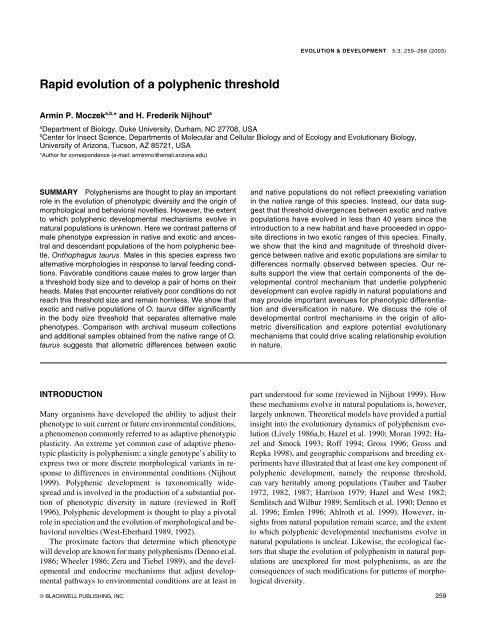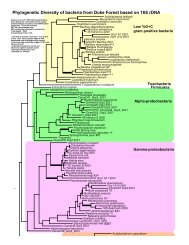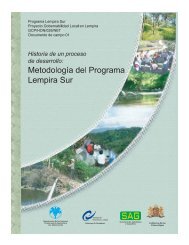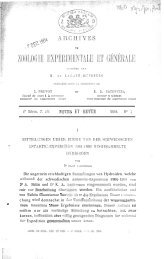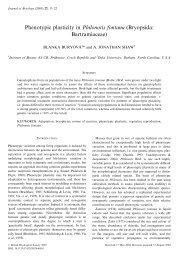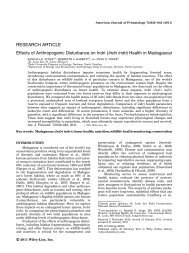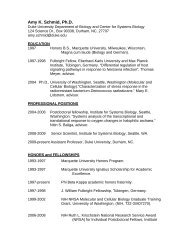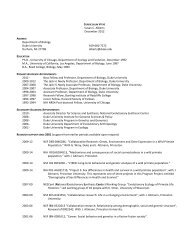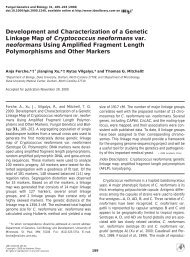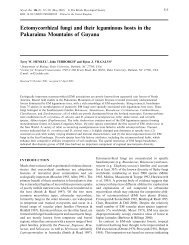Rapid evolution of a polyphenic threshold - Duke Biology - Duke ...
Rapid evolution of a polyphenic threshold - Duke Biology - Duke ...
Rapid evolution of a polyphenic threshold - Duke Biology - Duke ...
You also want an ePaper? Increase the reach of your titles
YUMPU automatically turns print PDFs into web optimized ePapers that Google loves.
<strong>Rapid</strong> <strong>evolution</strong> <strong>of</strong> a <strong>polyphenic</strong> <strong>threshold</strong><br />
a,b,<br />
a<br />
Armin P. Moczek * and H. Frederik Nijhout<br />
© BLACKWELL PUBLISHING, INC.<br />
EVOLUTION & DEVELOPMENT<br />
a<br />
Department <strong>of</strong> <strong>Biology</strong>, <strong>Duke</strong> University, Durham, NC 27708, USA<br />
b<br />
Center for Insect Science, Departments <strong>of</strong> Molecular and Cellular <strong>Biology</strong> and <strong>of</strong> Ecology and Evolutionary <strong>Biology</strong>,<br />
University <strong>of</strong> Arizona, Tucson, AZ 85721, USA<br />
*Author for correspondence (e-mail: arminmo@email.arizona.edu)<br />
SUMMARY Polyphenisms are thought to play an important<br />
role in the <strong>evolution</strong> <strong>of</strong> phenotypic diversity and the origin <strong>of</strong><br />
morphological and behavioral novelties. However, the extent<br />
to which <strong>polyphenic</strong> developmental mechanisms evolve in<br />
natural populations is unknown. Here we contrast patterns <strong>of</strong><br />
male phenotype expression in native and exotic and ancestral<br />
and descendant populations <strong>of</strong> the horn <strong>polyphenic</strong> beetle,<br />
Onthophagus taurus. Males in this species express two<br />
alternative morphologies in response to larval feeding conditions.<br />
Favorable conditions cause males to grow larger than<br />
a <strong>threshold</strong> body size and to develop a pair <strong>of</strong> horns on their<br />
heads. Males that encounter relatively poor conditions do not<br />
reach this <strong>threshold</strong> size and remain hornless. We show that<br />
exotic and native populations <strong>of</strong> O. taurus differ significantly<br />
in the body size <strong>threshold</strong> that separates alternative male<br />
phenotypes. Comparison with archival museum collections<br />
and additional samples obtained from the native range <strong>of</strong> O.<br />
taurus suggests that allometric differences between exotic<br />
INTRODUCTION<br />
Many organisms have developed the ability to adjust their<br />
phenotype to suit current or future environmental conditions,<br />
a phenomenon commonly referred to as adaptive phenotypic<br />
plasticity. An extreme yet common case <strong>of</strong> adaptive phenotypic<br />
plasticity is polyphenism: a single genotype’s ability to<br />
express two or more discrete morphological variants in response<br />
to differences in environmental conditions (Nijhout<br />
1999). Polyphenic development is taxonomically widespread<br />
and is involved in the production <strong>of</strong> a substantial portion<br />
<strong>of</strong> phenotypic diversity in nature (reviewed in R<strong>of</strong>f<br />
1996). Polyphenic development is thought to play a pivotal<br />
role in speciation and the <strong>evolution</strong> <strong>of</strong> morphological and behavioral<br />
novelties (West-Eberhard 1989, 1992).<br />
The proximate factors that determine which phenotype<br />
will develop are known for many polyphenisms (Denno et al.<br />
1986; Wheeler 1986; Zera and Tiebel 1989), and the developmental<br />
and endocrine mechanisms that adjust developmental<br />
pathways to environmental conditions are at least in<br />
5:3, 259–268 (2003)<br />
and native populations do not reflect preexisting variation<br />
in the native range <strong>of</strong> this species. Instead, our data suggest<br />
that <strong>threshold</strong> divergences between exotic and native<br />
populations have evolved in less than 40 years since the<br />
introduction to a new habitat and have proceeded in opposite<br />
directions in two exotic ranges <strong>of</strong> this species. Finally,<br />
we show that the kind and magnitude <strong>of</strong> <strong>threshold</strong> divergence<br />
between native and exotic populations are similar to<br />
differences normally observed between species. Our results<br />
support the view that certain components <strong>of</strong> the developmental<br />
control mechanism that underlie <strong>polyphenic</strong><br />
development can evolve rapidly in natural populations and<br />
may provide important avenues for phenotypic differentiation<br />
and diversification in nature. We discuss the role <strong>of</strong><br />
developmental control mechanisms in the origin <strong>of</strong> allometric<br />
diversification and explore potential <strong>evolution</strong>ary<br />
mechanisms that could drive scaling relationship <strong>evolution</strong><br />
in nature.<br />
part understood for some (reviewed in Nijhout 1999). How<br />
these mechanisms evolve in natural populations is, however,<br />
largely unknown. Theoretical models have provided a partial<br />
insight into the <strong>evolution</strong>ary dynamics <strong>of</strong> polyphenism <strong>evolution</strong><br />
(Lively 1986a,b; Hazel et al. 1990; Moran 1992; Hazel<br />
and Smock 1993; R<strong>of</strong>f 1994; Gross 1996; Gross and<br />
Repka 1998), and geographic comparisons and breeding experiments<br />
have illustrated that at least one key component <strong>of</strong><br />
<strong>polyphenic</strong> development, namely the response <strong>threshold</strong>,<br />
can vary heritably among populations (Tauber and Tauber<br />
1972, 1982, 1987; Harrison 1979; Hazel and West 1982;<br />
Semlitsch and Wilbur 1989; Semlitsch et al. 1990; Denno et<br />
al. 1996; Emlen 1996; Ahlroth et al. 1999). However, insights<br />
from natural population remain scarce, and the extent<br />
to which <strong>polyphenic</strong> developmental mechanisms evolve in<br />
natural populations is unclear. Likewise, the ecological factors<br />
that shape the <strong>evolution</strong> <strong>of</strong> polyphenism in natural populations<br />
are unexplored for most polyphenisms, as are the<br />
consequences <strong>of</strong> such modifications for patterns <strong>of</strong> morphological<br />
diversity.<br />
259
260 EVOLUTION & DEVELOPMENT<br />
Vol. 5, No. 3, May–June 2003<br />
Here we explore a case <strong>of</strong> rapid polyphenism <strong>evolution</strong> in<br />
the horn-<strong>polyphenic</strong> dung beetle Onthophagus taurus.<br />
Male<br />
O. taurus vary continuously in body size as a function <strong>of</strong> larval<br />
feeding conditions. Only males that exceed a critical<br />
body size <strong>threshold</strong> develop a pair <strong>of</strong> long curved horns on<br />
their heads, whereas males below this <strong>threshold</strong> remain<br />
hornless or develop only rudimentary horns (Fig. 1) (Hunt<br />
and Simmons 1997, 1998; Moczek 1998; Emlen and Nijhout<br />
1999; Moczek and Emlen 1999). As a consequence <strong>of</strong> this<br />
<strong>threshold</strong>, natural populations <strong>of</strong> O. taurus are composed <strong>of</strong><br />
two relatively discrete male phenotypes: horned and hornless<br />
(Paulian 1935; Hunt and Simmons 1997, 1998; Emlen<br />
and Nijhout 1999; Moczek and Emlen 1999). Male horn dimorphism<br />
coincides with a behavioral dimorphism because<br />
different horn phenotypes use strikingly different reproductive<br />
tactics to acquire mating opportunities (Emlen 1997;<br />
Moczek 1999; Moczek and Emlen 2000).<br />
Onthophagus taurus originally exhibited a circum-Mediterranean<br />
distribution (Balthasar 1963). As part <strong>of</strong> a dung beetle<br />
release program under the authority <strong>of</strong> the Commonwealth Scientific<br />
Research Organization (CSIRO) <strong>of</strong> Australia, O. taurus<br />
was introduced to several Australian states, including Western<br />
Australia (AMRC Workshop Report 1982; Tyndale-Biscoe<br />
1996). At least 36 releases with 500–1800 individuals per release<br />
took place between 1969 and 1983 (Tyndale-Biscoe<br />
1996). All beetles released were the direct descendants <strong>of</strong> parents<br />
collected in the native range <strong>of</strong> O. taurus.<br />
Parent beetles<br />
were collected in Spain, Greece, and Turkey, and a subset <strong>of</strong><br />
specimens belonging to the original parent populations has been<br />
preserved in entomological collections (Tyndale-Biscoe 1996).<br />
In the late 1960s O. taurus also became introduced to<br />
what is now its second major exotic range: the eastern United<br />
States. Unlike the deliberate release <strong>of</strong> O. taurus into Western<br />
Australia, the American introduction appears to have<br />
been accidental (Fincher and Woodruff 1975). Onthophagus<br />
taurus was first recorded in 1971 in St. Rosa County, Florida<br />
(Fincher and Woodruff 1975) and has since spread as far<br />
north as New York and as far west as Indiana (Hoebeke and<br />
Beucke 1997; Smith 1997). In North Carolina O. taurus has<br />
massively altered the native dung beetle fauna (Davis 1958)<br />
and now constitutes the dominant onthophagine species in<br />
many regions <strong>of</strong> the state (Moczek 1996, 2002a). The origin<br />
<strong>of</strong> the population that gave rise to the invasion <strong>of</strong> O. taurus<br />
<strong>of</strong> the eastern United States is unknown.<br />
Recent comparisons <strong>of</strong> Western Australian and North<br />
American populations <strong>of</strong> O. taurus revealed that both popula-<br />
Fig. 1. (A) Typical morphology <strong>of</strong> hornless<br />
and horned male O. taurus. (Drawings<br />
by Shane Richards.) (B) Typical<br />
sigmoidal scaling relationship between<br />
horn length and body size <strong>of</strong> male O. taurus.<br />
Males were collected in Durham and<br />
Orange County, North Carolina (n �<br />
1016). Inserts show frequency distributions<br />
for body size (top) and horn length<br />
(bottom), respectively.
Moczek and Nijhout<br />
tions have diverged dramatically in the <strong>threshold</strong> body size<br />
that separates alternative male morphologies (Moczek<br />
2002b). We showed previously that <strong>threshold</strong> divergence is<br />
maintained fully in the field and laboratory over generations<br />
(Moczek et al. 2002) and is mediated via genetic modifications<br />
<strong>of</strong> the endocrine control mechanisms that specify adult<br />
morphology during late larval development (Moczek and<br />
Nijhout 2002). Here we contrast patterns <strong>of</strong> male phenotype<br />
expression in native and exotic and ancestral and descendant<br />
populations <strong>of</strong> O. taurus and explore the magnitude, direction,<br />
and speed <strong>of</strong> <strong>threshold</strong> <strong>evolution</strong> in different populations. We<br />
begin by quantifying the scaling relationship between body<br />
size and horn length <strong>of</strong> male O. taurus collected in the 1960s<br />
from native populations in Spain, Greece, and Turkey that<br />
constituted the source material for the introduction <strong>of</strong> O. taurus<br />
to Western Australia. We then compare this scaling relationship<br />
with the one expressed by descendant present-day<br />
Western Australian populations less than 40 years after introduction.<br />
We then extend our comparison and include samples<br />
from the second exotic distribution <strong>of</strong> O. taurus in the eastern<br />
United States. Because in this case the origin <strong>of</strong> the founding<br />
populations is unknown, we include additional scaling relationships<br />
from the remainder <strong>of</strong> the circum-Mediterranean<br />
distribution <strong>of</strong> O. taurus into our analysis. Finally, we compare<br />
differences in scaling relationships between exotic and<br />
native O. taurus populations with those between native O. taurus<br />
populations and its sympatric sister species, O. illyricus<br />
(Balthasar 1965; Baraud 1992; Lohse and Lucht 1992).<br />
MATERIALS AND METHODS<br />
We used beetles collected in the field and museum specimens for<br />
our study. Present-day populations from the eastern United States<br />
were sampled in 1996 and 1997 from pastures in Durham and Orange<br />
Counties, North Carolina. Populations in Western Australia<br />
were sampled in 1997 at Margaret River and in 1998 near Busselton.<br />
Beetles were collected using whole dung pad samples. Specimens<br />
belonging to the original pool <strong>of</strong> individuals used to breed O.<br />
taurus for release into Western Australia were made available by<br />
the Australian National Insect Collection, CSIRO, Canberra, Australia.<br />
Additional specimens <strong>of</strong> European and North African origin<br />
were made available by the Australian National Insect Collection,<br />
Canberra, Australia; the Museo Nacional de Ciencias Naturales,<br />
Madrid, Spain; the South Africa National Collection <strong>of</strong> Insects, Pretoria,<br />
South Africa; and the Universita di Turino, Italy. Specimens<br />
<strong>of</strong> the sibling species O. illyricus were made available by the Universita<br />
di Turino, Italy, and the Australian National Insect Collection,<br />
Canberra, Australia.<br />
Morphometric measurements<br />
All individuals were measured using a standard two-dimensional<br />
image analysis system and Image s<strong>of</strong>tware at the <strong>Duke</strong> University<br />
Morphometrics Laboratory (for details see Moczek and Emlen<br />
<strong>Rapid</strong> <strong>evolution</strong> <strong>of</strong> a <strong>polyphenic</strong> <strong>threshold</strong><br />
261<br />
1999). Thorax width was used as an estimate for body size (for justification<br />
see Emlen 1994; Moczek and Emlen 1999).<br />
Statistical analysis<br />
To compare the location <strong>of</strong> the <strong>threshold</strong> body size between different<br />
populations, we fitted a modified sigmoid equation <strong>of</strong> the form<br />
a( body size)<br />
horn length y0 (1)<br />
b<br />
c b<br />
( body size)<br />
b<br />
� � ------------------------------------------<br />
�<br />
to all individuals collected from Spain, Greece, and Turkey (the<br />
source populations for the introduction into Western Australia),<br />
where a is the range <strong>of</strong> horn lengths in the sample, b is a slope coefficient,<br />
c is the body size at the point <strong>of</strong> inflection <strong>of</strong> the sigmoid,<br />
and y0<br />
is the minimum horn length. We used c,<br />
or the inflection<br />
point <strong>of</strong> the sigmoid, as an estimate <strong>of</strong> the average body size <strong>threshold</strong><br />
at which males switch from the hornless to the horned phenotype.<br />
To compare two samples, we first applied the above regression<br />
model to both samples combined (� simple model) and<br />
determined the parameter values that maximized the likelihood L <strong>of</strong><br />
our data given this model using the likelihood function:<br />
L �<br />
(2)<br />
2<br />
where xi<br />
is the body size <strong>of</strong> male i,<br />
� is the variance <strong>of</strong> the data<br />
about the fitted values, n is the number <strong>of</strong> beetles in the combined<br />
sample, and<br />
(3)<br />
We then repeated this analysis for each sample separately (complex<br />
model). We obtained a probability value by comparing the test statistic<br />
2 1<br />
( a, b, c, y0 ; x)<br />
2�� 2<br />
� -------------------- n<br />
--<br />
2<br />
( )<br />
1<br />
exp<br />
2� 2<br />
-------- ( yi � yˆ ( a , b,<br />
c,<br />
y0; xi) ) 2<br />
⎧ n<br />
⎫<br />
⎪ ⎪<br />
⎨��⎬ ⎪ i�1<br />
⎪<br />
⎩ ⎭<br />
ax<br />
yi( a , b,<br />
c , y0; x)<br />
y0 b<br />
c b<br />
ˆ<br />
� � --------------------b<br />
� axi T � 2 ln (likelihood <strong>of</strong> the complex model (4)<br />
� likelihood <strong>of</strong> the simple model)<br />
2 to a � distribution with degrees <strong>of</strong> freedom equal to the difference<br />
in the number <strong>of</strong> parameters between the two models (Edwards<br />
1972; Weir 1990). If significant differences were indicated, we<br />
used repeated Welch’s T-tests to examine the degree to which differences<br />
in particular regression parameters, such as the inflection<br />
point or slope, explained allometric differences between samples<br />
(Sachs 1992; Sokal and Rohlf 1995). All significance levels reported<br />
below are adjusted for multiple comparisons using sequential<br />
Bonferroni corrections where this was necessary (Sachs 1992;<br />
Sokal and Rohlf 1995). Unless otherwise noted, all data are presented<br />
as means � standard error. Results from Welch’s T- tests for<br />
pair-wise comparisons <strong>of</strong> parameter estimates are presented as<br />
Tdf<br />
� test statistic.<br />
All males collected in Greece and Turkey came from the original<br />
pool <strong>of</strong> individuals used to breed O. taurus for release into<br />
Western Australia. Males collected from Spain were <strong>of</strong> two origins:<br />
one subsample belonged to the original field sample used to seed
262 EVOLUTION & DEVELOPMENT<br />
Vol. 5, No. 3, May–June 2003<br />
the Australian introduction and one subsample came from other<br />
Spanish populations. Using the method outlined above, we tested<br />
whether both subsamples <strong>of</strong> males differed significantly in the<br />
average horn length–body size allometry. We found no significant<br />
differences between the two subsamples and therefore combined<br />
both subsamples for further analyses to increase statistical<br />
power.<br />
RESULTS<br />
Western Australian populations<br />
and their ancestors<br />
Log-likelihood contrasts and subsequent pair-wise parameter<br />
comparisons for individuals collected from Spain,<br />
Greece, and Turkey revealed significant differences in allometric<br />
parameter values in three instances (Table 1A). Onthophagus<br />
taurus males collected in Spain exhibited a significantly<br />
higher slope coefficient than males collected in<br />
Turkey (T191<br />
� 2.059, P � 0.05) or Greece (T35<br />
� 2.51; P �<br />
0.05). In addition, O. taurus collected in Greece exhibited a<br />
significantly smaller range <strong>of</strong> horn lengths (parameter y0 )<br />
than males collected in Spain (T130 � 2.96; P � 0.01). We<br />
found no significant differences in body size <strong>threshold</strong>s (parameter<br />
c) or minimum horn length (parameter a) between<br />
any <strong>of</strong> the three source populations for the Western Australian<br />
introduction (Table 1A).<br />
In contrast, Western Australian males did not differ significantly<br />
in slope coefficients when compared with any <strong>of</strong><br />
the source populations. Instead, Western Australian males<br />
differed highly significantly in the average body size <strong>threshold</strong><br />
that separates horned and hornless male phenotypes (P �<br />
0.0001 for each comparison, Table 1A). Extant Western<br />
Australian populations expressed the hornless morph over a<br />
much wider range <strong>of</strong> body sizes and switched to the horned<br />
morph at a much larger body size than any <strong>of</strong> their Mediterranean<br />
ancestors (Fig. 2, A and B). In addition, O. taurus collected<br />
in Greece exhibited a significantly smaller range <strong>of</strong><br />
horn lengths (parameter a) than Western Australian males<br />
(T 103 � 3.09; P � 0.01).<br />
North Carolinian and Mediterranean populations<br />
Onthophagus taurus males collected in North Carolina also<br />
differed highly significantly from males collected in Spain,<br />
Greece, or Turkey. Significant differences between samples<br />
could be attributed entirely (Spain, Turkey) or largely<br />
(Greece) to differences in the body size <strong>threshold</strong> (parameter<br />
c, P � 0.0001 in each case; Table 1A). In these cases, however,<br />
males in the exotic North Carolinian range switched to<br />
the horned phenotype at much smaller body sizes and expressed<br />
the horned morph over a much wider range <strong>of</strong> body<br />
sizes than their Mediterranean counterparts (Fig. 2, A and<br />
B). Onthophagus taurus collected in Greece also exhibited a<br />
significantly smaller range <strong>of</strong> horn lengths (parameter a)<br />
than North Carolinian males (T 54 � 3.19; P � 0.05).<br />
Because the founding populations that gave rise to the<br />
North Carolinian introduction could have originated from<br />
Mediterranean regions other than Spain, Greece, or Turkey,<br />
we extended our analysis to include males collected from<br />
Table 1. Intra- and interspecific allometric variation in onthophagine beetles<br />
Regression parameters<br />
Sample a b c y0 n<br />
A. Intraspecific allometric parameter values (mean � SE) for O. taurus collected from native and exotic ranges.<br />
Native<br />
Spain 4.09 � 0.169a 38.55 � 4.358 a,f<br />
5.12 � 0.016 a<br />
0.42 � 0.074 a<br />
Greece 3.49 � 0.114 b<br />
61.26 � 7.912 c<br />
5.14 � 0.015 a<br />
0.48 � 0.056 b<br />
Turkey 3.72 � 0.125 a,b<br />
53.20 � 5.623 b,c<br />
5.15 � 0.012 a<br />
0.54 � 0.029 a,b<br />
France 3.83 � 0.225 a,b<br />
58.09 � 9.037 c,d,e,f<br />
5.10 � 0.029 a<br />
0.48 � 0.072 a,b<br />
Italy 4.21 � 1.063 a,b<br />
29.36 � 12.99 a,b,c<br />
5.10 � 0.084 a,b<br />
0.25 � 0.789 a,b<br />
Iran 4.07 � 0.199 a,b<br />
34.35 � 4.422 a,b,d<br />
5.16 � 0.024 a<br />
0.45 � 0.082 a,b<br />
Morocco and Tunisia 4.13 � 0.312 a,b<br />
35.38 � 5.986 a,e<br />
5.19 � 0.031 a<br />
0.42 � 0.095 a,b<br />
Exotic<br />
North Carolina 3.985 � 0.090 a<br />
38.50 � 2.037 a,b<br />
4.98 � 0.007 b<br />
0.42 � 0.056 a<br />
Western Australia 4.02 � 0.129 a<br />
45.97 � 3.059 c,d,e<br />
5.33 � 0.010 c<br />
0.50 � 0.036 a<br />
B. Interspecific allometric parameter values (mean � SE) for native sympatric populations <strong>of</strong> O. taurus and O. illyricus.<br />
Native O. taurus 3.99 � 0.091 1<br />
Native O. illyricus 4.00 � 0.262 1<br />
38.19 � 2.331 1<br />
135.2 � 43.43 2<br />
5.14 � 0.010 1<br />
5.42 � 0.013 2<br />
0.45 � 0.036 1<br />
0.50 � 0.142 1<br />
a specifies the range <strong>of</strong> horn lengths within a sample (amplitude), b specifies a slope coefficient, c represents the body size at the point <strong>of</strong> inflection<br />
<strong>of</strong> the sigmoid, and y 0 specifies minimum horn length. Different exponents indicate significant differences between samples (P � 0.05;<br />
multiple Welch’s T-tests including sequential Bonferroni correction for multiple comparisons).<br />
159<br />
22<br />
91<br />
21<br />
33<br />
117<br />
64<br />
1016<br />
644<br />
507<br />
30
Moczek and Nijhout <strong>Rapid</strong> <strong>evolution</strong> <strong>of</strong> a <strong>polyphenic</strong> <strong>threshold</strong> 263<br />
other Mediterranean populations, including France, Italy,<br />
Iran, Tunisia, and Morocco. In each comparison, differences<br />
between males collected in North Carolina and the Mediterranean<br />
were significant (P � 0.01 for each comparison; Table<br />
1A). With one exception (Italy, see below), differences<br />
between males collected in North Carolina and in other Mediterranean<br />
samples were attributable entirely (Morocco, Tunisia,<br />
Iran) or largely (France) to differences in the body size<br />
<strong>threshold</strong> (parameter c, P � 0.001 in each case). As before,<br />
North Carolinian males switched to the horned phenotype at<br />
much smaller body sizes and expressed the horned morph<br />
over a much wider range <strong>of</strong> body sizes than their Mediterranean<br />
counterparts (Fig. 2, A and C). French O. taurus also<br />
exhibited a marginally significantly higher slope coefficient<br />
than males collected in North Carolina (T 22 � 2.11; P �<br />
0.046). Interestingly, although log-likelihood contrasts between<br />
males collected in North Carolina and Italy suggested<br />
significant allometric differences between these two populations,<br />
none <strong>of</strong> the four regression parameters was able to account<br />
for these differences. A potential explanation for this<br />
observation may lie in the unusually wide spread <strong>of</strong> data<br />
points within the Italian sample (see Fig. 2C) and a relatively<br />
modest sample size (n � 33).<br />
Pair-wise comparison <strong>of</strong> all<br />
Mediterranean populations<br />
Eighteen pair-wise log-likelihood contrasts <strong>of</strong> all Mediterranean<br />
populations, excluding those between Spain, Greece,<br />
and Turkey presented above, yielded additional significant<br />
differences in seven cases. Three <strong>of</strong> these (two <strong>of</strong> which involved<br />
Italy, see above) could not be accounted for by any <strong>of</strong><br />
the regression parameters. In the three remaining cases, differences<br />
were due to significant differences in the slope<br />
coefficient (parameter b) between samples (Table 1A). No<br />
pair-wise comparison indicated significant differences in parameter<br />
c, suggesting that over most <strong>of</strong> their native geographic<br />
range, male O. taurus employ a similar <strong>threshold</strong><br />
body size to switch from hornless to horned morphologies<br />
(Fig. 2, B and C).<br />
Intra- versus interspecific differences<br />
When compared with each other, Western Australian and<br />
North Carolinian populations differed most dramatically in<br />
the <strong>threshold</strong> body size (T 1191 � 28.92; P � 0.0001), causing<br />
both populations to express opposite phenotypes over a wide<br />
range <strong>of</strong> body sizes (Table 1A, Fig. 2A). In addition, Western<br />
Australian males also expressed a slightly but significantly<br />
higher slope coefficient than their North Carolinian<br />
counterparts (T 1191 � 2.03; P � 0.05).<br />
Onthophagus taurus shares much <strong>of</strong> its native range with<br />
O. illyricus (Balthasar 1963). Onthophagus illyricus also expresses<br />
two alternative male horn morphologies very similar<br />
to those <strong>of</strong> O. taurus (Balthasar 1963; Baraud 1992; Lohse<br />
and Lucht 1992). In fact, the two species are very difficult to<br />
distinguish on the basis <strong>of</strong> external morphological characters<br />
alone and were originally considered varieties <strong>of</strong> the same<br />
species (Balthasar 1963). Male genital morphology, however,<br />
allows for a clear and unambiguous separation <strong>of</strong> both<br />
species and provides a reliable species-diagnostic character<br />
(Lohse and Lucht 1992; Krell, personal communication).<br />
Onthophagus taurus and O. illyricus are now considered sister<br />
species (Baraud 1992; Lohse and Lucht 1992). Exotic O.<br />
taurus populations do not contain O. illyricus (Krell, personal<br />
communication).<br />
Mediterranean O. taurus and sympatric male O. illyricus<br />
differed highly significantly in the average horn length–body<br />
size allometry (L 4 � 159.73). Differences between the two<br />
species were attributable largely to highly significant differences<br />
in the infection point c (T 72 � 17.21; P � 0.0001), suggesting<br />
that apart from genital characters, both species can<br />
also be distinguished by the body size <strong>threshold</strong> between alternate<br />
morphs (Fig. 3). In addition, O. illyricus exhibited a<br />
marginally significantly higher slope coefficient (T 29 � 2.23;<br />
P � 0.0336) than Mediterranean O. taurus. Differences in<br />
<strong>threshold</strong> body sizes and slope coefficients between Mediterranean<br />
O. taurus and O. illyricus were similar in kind and<br />
magnitude to the differences between North Carolinian and<br />
Western Australian populations <strong>of</strong> O. taurus and between<br />
exotic and native O. taurus populations (Table 1B). Combined,<br />
these data suggest that the current morphological divergences<br />
<strong>of</strong> exotic O. taurus populations in North Carolina<br />
and Western Australia may be similar to patterns <strong>of</strong> morphological<br />
differentiation associated with the early stages in the<br />
formation <strong>of</strong> new species in the genus Onthophagus.<br />
Discussion<br />
Polyphenisms are a common extreme <strong>of</strong> phenotypically<br />
plastic trait expression and rely on <strong>threshold</strong> responses to<br />
produce discrete alternative phenotypes (Nijhout 1994; R<strong>of</strong>f<br />
1996; Stearns 1989). Threshold responses are widespread<br />
and essential components <strong>of</strong> many physiological and developmental<br />
processes yet have only relatively recently regained<br />
attention from <strong>evolution</strong>ary biologists (Schmalhausen<br />
1949; Tauber and Tauber 1970; Hazel and West<br />
1982; West-Eberhard 1989, 1992; Kingsolver 1995; Emlen<br />
1996, 2000; R<strong>of</strong>f 1996; Zera and Denno 1997; Hazel et al.<br />
1998; Schlichting and Pigliucci 1998; Lively et al. 1999;<br />
Nijhout 1999; Tomkins 1999). Here we show that exotic and<br />
native populations <strong>of</strong> the <strong>polyphenic</strong> beetle O. taurus differ<br />
most dramatically in the <strong>threshold</strong> body size that separates<br />
alternative male phenotypes. The kind and magnitude <strong>of</strong><br />
<strong>threshold</strong> divergences between native and exotic populations<br />
do not reflect variation in the native range <strong>of</strong> O. taurus but<br />
instead resemble differences normally observed between
264 EVOLUTION & DEVELOPMENT Vol. 5, No. 3, May–June 2003
Moczek and Nijhout <strong>Rapid</strong> <strong>evolution</strong> <strong>of</strong> a <strong>polyphenic</strong> <strong>threshold</strong> 265<br />
Fig. 3. Scaling relationship between body size and horn length <strong>of</strong><br />
male O. taurus (open circles and dashed line) and O. illyricus<br />
(black circles and solid line) collected from native Mediterranean<br />
populations. Lines represent best-fit nonlinear regressions calculated<br />
separately for both samples (see text for details and Table 1<br />
for parameter values).<br />
species. Our results suggest that <strong>threshold</strong> differences between<br />
exotic O. taurus populations have evolved in less than<br />
40 years since the introduction to a new habitat and that<br />
<strong>threshold</strong> <strong>evolution</strong> proceeded in opposite directions in both<br />
exotic ranges. Combined, our results support the view that<br />
certain components <strong>of</strong> <strong>polyphenic</strong> development, such as the<br />
response <strong>threshold</strong>, can evolve rapidly in natural populations<br />
and may provide important avenues for phenotypic differentiation<br />
and diversification in nature.<br />
Developmental basis <strong>of</strong> allometric diversification<br />
Threshold response<br />
We used four parameters to characterize the average scaling<br />
relationship between horn length and body size in native and<br />
exotic O. taurus populations. Of those, the <strong>threshold</strong> body<br />
size c, or point <strong>of</strong> inflection <strong>of</strong> the sigmoid, is understood<br />
best with respect to its underlying developmental mechanisms.<br />
Earlier studies showed that horns develop only in<br />
male larvae that exceed a critical weight <strong>threshold</strong> (Emlen<br />
and Nijhout 1999). Horn expression can be induced experimentally<br />
in smaller male larvae via topical application <strong>of</strong> juvenile<br />
hormone analogs, provided a certain minimum dosage<br />
is applied and application occurs during a particular time<br />
window or sensitive period (Moczek and Nijhout 2002).<br />
Combined, these findings suggested that juvenile hormone<br />
titers may be correlated with larval weight during a sensitive<br />
period, where they are then used to differentiate between two<br />
alternative developmental pathways. Although juvenile hormone<br />
titers have yet to be measured in O. taurus, similar regulatory<br />
mechanisms have been observed in a variety <strong>of</strong> other<br />
insect polyphenisms (Nijhout 1994, 1999). Apart from providing<br />
a first insight into the developmental regulation <strong>of</strong><br />
horns, these findings also suggested at least two avenues for<br />
<strong>evolution</strong>ary modifications <strong>of</strong> the body size <strong>threshold</strong>. For<br />
example, changes in sensitivity to juvenile hormone, or<br />
changes in the timing <strong>of</strong> sensitivity to juvenile hormone relative<br />
to other developmental events, could modify the range<br />
<strong>of</strong> larval body weights that would fall above or below the<br />
<strong>threshold</strong> required for horn induction (Moczek and Nijhout<br />
2002). Both hypotheses recently received experimental support.<br />
Allometrically divergent laboratory strains derived<br />
from North Carolinian and Western Australian populations<br />
were found to differ in both the degree and timing <strong>of</strong> sensitivity<br />
to the juvenile hormone analog methoprene. To induce<br />
horn expression, presumptive hornless male Western Australian<br />
larvae required higher methoprene dosages and expressed<br />
a delay in their sensitive period by 2–3 days compared<br />
with their North Carolinian counterparts (Moczek and<br />
Nijhout 2002). These findings therefore suggest that the divergence<br />
in body size <strong>threshold</strong>s between exotic and native<br />
O. taurus populations may have been mediated by <strong>evolution</strong>ary<br />
modifications in the degree and timing <strong>of</strong> sensitivity to<br />
juvenile hormone.<br />
Range <strong>of</strong> horn lengths and slope<br />
The present study occasionally detected significant differences<br />
between samples in the range <strong>of</strong> horn lengths (amplitude,<br />
a) and, more commonly, in slope (b), though some <strong>of</strong><br />
these results may have been influenced by small sample<br />
sizes. However, in at least two cases, significant differences<br />
in slope could not be attributed to insufficient sample sizes.<br />
For example, Western Australian males (n � 644) expressed<br />
significantly higher slope coefficients than their North Carolinian<br />
(n � 1016) counterparts. Like differences in <strong>threshold</strong><br />
body sizes, differences in slope coefficients were <strong>of</strong> a magnitude<br />
similar to differences between O. taurus and O. illyricus.<br />
Unlike differences in <strong>threshold</strong> body sizes, however,<br />
Fig. 2. Scaling relationship between body size and horn length <strong>of</strong> male O. taurus from native (open symbols) and exotic (gray circles)<br />
populations. (A) Body size–horn length allometry <strong>of</strong> males collected from exotic populations in Western Australia (left) and North Carolina<br />
(right). (B) Body size–horn length allometry <strong>of</strong> males preserved from ancestral Mediterranean populations collected in Spain,<br />
Greece, and Turkey to found the Australian introduction. (C) Body size–horn length allometry <strong>of</strong> males collected from the remainder<br />
<strong>of</strong> the native geographic range <strong>of</strong> O. taurus. Solid lines represent best-fit nonlinear regressions calculated separately for each sample. For<br />
ease <strong>of</strong> interpretation the dashed line is provided as a visual reference (identical in all graphs) and represents the best-fit nonlinear regression<br />
for all Mediterranean samples combined (see text for details and Table 1 for parameter values).
266 EVOLUTION & DEVELOPMENT Vol. 5, No. 3, May–June 2003<br />
significant differences in slope coefficients were also detected<br />
between populations within the native range <strong>of</strong> O. taurus.<br />
For instance, males collected in Turkey (n � 91) expressed<br />
significantly higher slope coefficients than males<br />
collected in Spain. This suggests that differences in slope<br />
could have been present in the native range <strong>of</strong> O. taurus before<br />
introduction to the United States and Australia. Our results<br />
nevertheless indicate that significant phenotypic and<br />
possibly genetic variation in slope exists in nature, which<br />
may provide additional, and previously overlooked, opportunities<br />
for <strong>evolution</strong>ary diversification <strong>of</strong> horn length–body<br />
size allometries.<br />
Unfortunately, relatively little is known about the developmental<br />
basis <strong>of</strong> allometric parameters such as slope or amplitude.<br />
Recent studies have shown, however, that horns develop<br />
from imaginal disk-like structures that undergo rapid<br />
cell divisions during the prepupal stage, much like the imaginal<br />
disks that give rise to legs, mouthparts, antennae, and<br />
genitalia in holometabolous insects (Emlen and Nijhout<br />
1999; Moczek and Nagy, unpublished data). Therefore, insights<br />
into the nature and regulation <strong>of</strong> imaginal disk development<br />
may be <strong>of</strong> help in understanding the developmental<br />
basis <strong>of</strong> allometric shape parameters and their <strong>evolution</strong>ary<br />
significance. For example, imaginal disks undergo most <strong>of</strong><br />
their growth in the closed environment <strong>of</strong> the prepupal and<br />
pupal stage at the expense <strong>of</strong> nutrients accumulated during<br />
larval life. Because growth occurs in a closed environment<br />
without further input <strong>of</strong> resources from the outside, there is<br />
a potential for trade-<strong>of</strong>fs for resources during growth <strong>of</strong><br />
imaginal disks, such that an increase in one disk is <strong>of</strong>ten<br />
associated with the relative diminution <strong>of</strong> another disk.<br />
Increased horn size in O. taurus, for instance, occurs at the<br />
expense <strong>of</strong> eye size (Nijhout and Emlen 1998). Such competition<br />
among disks has the potential to result in the highly<br />
nonlinear (hyperbolic and sigmoid) allometries that are so<br />
common in adult insects (Nijhout and Wheeler 1995; Emlen<br />
and Nijhout 2000). The exact shape <strong>of</strong> such allometries is<br />
further influenced in part by the sizes <strong>of</strong> the disks relative to<br />
the available nutrient pool and by the relative ability <strong>of</strong> different<br />
disks to compete for resources during growth (Nijhout<br />
and Wheeler 1995). Thus, <strong>evolution</strong>ary changes in insect<br />
scaling relationships, including changes in the slope or amplitude<br />
<strong>of</strong> an allometry, may not only proceed via <strong>evolution</strong>ary<br />
changes in endocrine control mechanisms but may also<br />
be brought about through <strong>evolution</strong>ary changes in the growth<br />
and competition parameters <strong>of</strong> imaginal discs.<br />
Behavioral ecology <strong>of</strong> <strong>threshold</strong> <strong>evolution</strong><br />
Our results indicate that modifications <strong>of</strong> the <strong>threshold</strong> body<br />
size that separates hornless and horned morphs can evolve<br />
extraordinarily rapidly in geographically isolated populations<br />
and may precede, rather than follow, the <strong>evolution</strong> <strong>of</strong> reproductive<br />
isolation. An important implication <strong>of</strong> our findings is<br />
therefore that allometric diversification may be relatively easy<br />
to achieve, provided appropriate driving forces are in place.<br />
A likely <strong>evolution</strong>ary mechanism underlying allometric<br />
divergence <strong>of</strong> exotic populations from their ancestors is random<br />
genetic drift, in particular if exotic populations are<br />
founded by an accidental introduction <strong>of</strong> a small population,<br />
which is likely to have been the case for the introduction <strong>of</strong><br />
O. taurus to North Carolina. Even though the introduction <strong>of</strong><br />
O. taurus to Western Australia was deliberate, with 36 documented<br />
releases between 1969 and 1983 with 500–1800 individuals<br />
per release (Tyndale-Biscoe 1996), drift could<br />
nonetheless have played an important role in the <strong>evolution</strong> <strong>of</strong><br />
new body size <strong>threshold</strong>s. For example, knowledge <strong>of</strong> the<br />
exact habitat requirements <strong>of</strong> O. taurus at the time <strong>of</strong> introduction<br />
was limited, and several releases took place in regions<br />
or at times during the season where it would have been<br />
difficult for this species to establish itself (Tyndale-Biscoe<br />
1996; Feehan and Weir, personal communication). Genetic<br />
drift due to local extinctions could therefore have contributed<br />
to <strong>threshold</strong> divergences in Western Australian populations.<br />
If this is correct, however, then present-day allometries<br />
in North Carolinian and Western Australian populations<br />
should overlap with preexisting allometric variation in the<br />
native range <strong>of</strong> this species. Our present study, however, indicates<br />
that this is not the case. Average Western Australian<br />
and North Carolinian body size <strong>threshold</strong>s do not reflect opposite<br />
extremes present in the native range <strong>of</strong> O. taurus but<br />
instead are both clearly outside the range <strong>of</strong> body size <strong>threshold</strong>s<br />
documented so far for native O. taurus populations.<br />
This therefore points toward an alternative explanation for<br />
the <strong>evolution</strong>ary mechanism behind this divergence and suggests<br />
that rather than a consequence <strong>of</strong> random genetic drift,<br />
divergent <strong>threshold</strong>s in exotic O. taurus populations may reflect<br />
a response to divergent selective environments within<br />
which alternative male morphs function.<br />
Male horn polyphenism in O. taurus plays an important role<br />
in male reproductive behavior, and both male phenotypes adopt<br />
strikingly different coadapted behaviors to gain mating opportunities<br />
(Emlen 1997, 2000; Moczek 1999; Moczek and Emlen<br />
2000). Large horned males rely exclusively on aggressive behaviors<br />
involving fights and the use <strong>of</strong> horns as weapons to gain<br />
and defend access to breeding tunnels that contain females<br />
(Moczek and Emlen 2000), and larger males almost always win<br />
fights against smaller males (Emlen 1997). Small hornless<br />
males instead engage in nonaggressive sneaking behaviors to<br />
circumvent large horned males (Moczek and Emlen 2000).<br />
The possession <strong>of</strong> long horns confers an advantage to<br />
males that engage in fights but is detrimental to the performance<br />
<strong>of</strong> males that engage in sneaking behaviors (Moczek<br />
and Emlen 2000). Therefore, only males that are sufficiently<br />
large for fighting to provide the tactic that yields the highest<br />
fitness gain should develop horns. Small males, given their<br />
low competitive status, may gain higher fitness by engaging
Moczek and Nijhout <strong>Rapid</strong> <strong>evolution</strong> <strong>of</strong> a <strong>polyphenic</strong> <strong>threshold</strong> 267<br />
in sneaking rather than fighting and should therefore remain<br />
hornless. Such a selection environment would favor genotypes<br />
that match the developmental switch from no to complete<br />
horn expression to a body size that corresponds to the<br />
point <strong>of</strong> equal fitness between fighting and sneaking tactics<br />
(Moczek et al. 2002; for a general derivation <strong>of</strong> this model, see<br />
Hazel et al. 1990; Gross 1996). However, the optimal body<br />
size at which to switch from sneaking to fighting behaviors<br />
may vary as a function <strong>of</strong> external conditions (Gross 1996).<br />
For example, because fights are energetically costly, an increase<br />
in the local density <strong>of</strong> competing males, with a corresponding<br />
increase in the frequency <strong>of</strong> male–male encounters,<br />
may allow only but the very largest and strongest males to<br />
benefit from engaging in fights. Under high density conditions,<br />
sneaking behavior may thus become pr<strong>of</strong>itable over a<br />
wider range <strong>of</strong> body sizes, which in turn would favor a corresponding<br />
shift <strong>of</strong> the <strong>threshold</strong> for horn production to larger<br />
body sizes (Moczek 2002b, Moczek 2003). Fitness estimates<br />
<strong>of</strong> both male morphs under a range <strong>of</strong> environmental conditions<br />
are clearly needed to test such hypotheses. We are currently<br />
exploring whether allometrically divergent populations<br />
indeed exhibit consistent differences in demographic factors<br />
and the extent to which such factors have the power to result<br />
in selection on body size <strong>threshold</strong>s in onthophagine beetles.<br />
Acknowledgments<br />
We are indebted to T. Weir for his much appreciated support and advice<br />
throughout the course <strong>of</strong> this study and to J. Hunt for collecting<br />
O. taurus in Western Australia. Special thanks go to D. Higdon and<br />
the <strong>Duke</strong> University Statistical Consulting Center for developing the<br />
likelihood analysis and for expert advice on the statistical analysis <strong>of</strong><br />
allometries. F. T. Krell confirmed species identity for all our samples<br />
and ensured that North Carolinian and Western Australian O. taurus<br />
populations were free <strong>of</strong> O. illyricus. T. Weir, J. Ridsdill-Smith, R.<br />
Staals, P. E. Skelley, and E. Barbero helped to make museum material<br />
available to us. We thank the following institutions for providing<br />
specimen loans: the Australian National Insect Collection, CSIRO,<br />
Canberra, Australia; the Museo Nacional de Ciencias Naturales,<br />
Madrid, Spain; the South Africa National Collection <strong>of</strong> Insects, Pretoria,<br />
South Africa; and the Universita di Turino, Italy. We thank J.<br />
Hunt, J. Feehan, J. Ridsdill-Smith, S. Shattuck, L. W. Simmons, and<br />
J. Tomkins for logistic support and J. Mercer and the <strong>Duke</strong> Morphometrics<br />
Laboratory for access to equipment. We thank S. Richards for<br />
his excellent drawings <strong>of</strong> O. taurus, and C. Patel for her assistance in<br />
locating taxonomic literature on O. illyricus. A. P. M. was funded by<br />
the Department <strong>of</strong> Zoology and <strong>Biology</strong>, <strong>Duke</strong> University, a National<br />
Science Foundation Dissertation Improvement Grant IBN 9972567,<br />
a Sally Hughes-Schrader International Fellowship, a <strong>Duke</strong> University<br />
Grant for International Studies, a Robert R. Bryden/North Carolina<br />
Academy <strong>of</strong> Science Fellowship, a Sigma Xi Grant-in-Aid <strong>of</strong><br />
Research, and a Katheryn Stern Fellowship. H. F. N. was funded in<br />
part by NSF grant IBN 9728727.<br />
REFERENCES<br />
Ahlroth, P., Alatalo, R. V., Hyvärinen. E., and Suhonen, J. 1999. Geographical<br />
variation in wing polymorphism in the water strider Aquarius<br />
najas (Heteroptera: Gerridae). J. Evol. Biol. 12: 156–160.<br />
Australian Meat Research Committee (AMRC) Workshop Report. 1982.<br />
The Biological Control <strong>of</strong> Dung in Australia. Commonwealth Scientific<br />
Research Organization, Canberra.<br />
Balthasar, V. 1963. Monographie der Scarabaeidae und Aphodiidae der<br />
palaearktischen und orientalischen Region (Coleoptera: Lamellicornia).<br />
Band 2, Coprinae. Verlag der tschechoslowakischen Akademie der<br />
Wissenschaften. Prag.<br />
Baraud, J. 1992. Coléoptères scarabaeiodea d’Europe. Fédéracion<br />
Française des Sociétiés des Sciences Naturelles, Paris.<br />
Davis, L. V. 1958. The Scarabaeidae <strong>of</strong> Durham and Orange Counties,<br />
North Carolina. MS thesis, <strong>Duke</strong> University, North Carolina.<br />
Denno, R. F., Douglass, L. W., and Jacobs, D. 1986. Effects <strong>of</strong> crowding<br />
and host plant nutrition on a wing-dimorphic planthopper. Ecology 67:<br />
116–123.<br />
Denno, R. F., Roderick, G., Peterson, M. A., Huberty, A. F., Döbel, H. G.,<br />
Eubanks, M. D., Losey J. E., and Langellotto, G. A. 1996. Habitat persistence<br />
underlies intraspecific variation in the dispersal strategies <strong>of</strong><br />
planthoppers. Ecol. Monogr. 66: 389–408.<br />
Edwards, A. W. F. 1972. Likelihood. Cambridge University Press. Cambridge,<br />
UK.<br />
Emlen, D. J. 1994. Environmental control <strong>of</strong> horn length dimorphism in<br />
the beetle Onthophagus acuminatus (Coleoptera: Scarabaeidae). Proc.<br />
R. Soc. Lond. B 256: 131–136.<br />
Emlen, D. J. 1996. Artificial selection on horn length-body size allometry<br />
in the horned beetle Onthophagus acuminatus (Coleoptera: Scarabaeidae).<br />
Evolution 50: 1219–1230.<br />
Emlen, D. J. 1997. Alternative reproductive tactics and male-dimorphism<br />
in the horned beetle Onthophagus acuminatus (Coleoptera: Scarabaeidae).<br />
Behav. Ecol. Sociobiol. 41: 335–341.<br />
Emlen, D. J. 2000. Integrating development with <strong>evolution</strong>: a case study<br />
with beetle horns. Bioscience 50: 403–418.<br />
Emlen, D. J., and Nijhout, H. F. 1999. Hormonal control <strong>of</strong> male horn<br />
length dimophism in the dung beetle Onthophagus taurus (Coleoptera:<br />
Scarabaeidae). J. Ins. Physiol. 45: 45–53.<br />
Emlen, D. J., and Nijhout, H. F. 2000. The development and <strong>evolution</strong> <strong>of</strong><br />
exaggerated morphologies in insects. Annu. Rev. Entomol. 45: 661–708.<br />
Fincher, G. T., and Woodruff, R. E. 1975. A European dung beetle, Onthophagus<br />
taurus Schreber, new to the U.S. (Coleoptera: Scarabaeidae).<br />
Coleopt. Bull. 29: 349–350.<br />
Gross, M. R. 1996. Alternative reproductive strategies and tactics: diversity<br />
within sexes. Trends Ecol. Evol. 11: 92–98.<br />
Gross, M. R., and Repka, J. 1998. Stability with inheritance in the conditional<br />
strategy. J. Theor. Biol. 192: 445–453.<br />
Harrison, R. G. 1979. Flight polymorphism in the field cricket Gryllus<br />
pennsylvanicus. Oecologia 40: 125–132.<br />
Hazel, W. N., and Smock, R. 1993. Modeling selection on conditional strategies<br />
in stochastic environments. In J. Yoshimura, and C. W. Clark<br />
(eds.). Adaptation in Stochastic Environments. Springer-Verlag, Berlin,<br />
pp. 147–154.<br />
Hazel, W. N., and West, D. A. 1982. Pupal colour dimorphism in swallowtail<br />
butterflies as a <strong>threshold</strong> trait: selection in Eurytides marcellus<br />
(Cramer). Heredity 49: 295–301.<br />
Hazel, W. N., Smock, R., and Johnson, M. D. 1990. A polygenic model for<br />
the <strong>evolution</strong> and maintenance <strong>of</strong> conditional strategies. Proc. R. Soc.<br />
Lond. B 242: 181–187.<br />
Hazel, W. N., Ante, S., and Stringfellow B. 1998. The <strong>evolution</strong> <strong>of</strong> environmentally-cued<br />
pupal colour in swallowtail butterflies: natural selection<br />
for pupation site and pupal colour. Ecol. Entomol. 23: 41–44.<br />
Hoebeke, R. E., and Beucke K. 1997. Adventive Onthophagus (Coleoptera:<br />
Scarabaeidae) in North America: geographic ranges, diagnoses,<br />
and new distributional records. Entomol. News 108: 345–362.<br />
Hunt, J., and Simmons, L. W. 1997. Patterns <strong>of</strong> fluctuating asymmetry in<br />
beetle horns: an experimental examination <strong>of</strong> the honest signalling hypothesis.<br />
Behav. Ecol. Sociobiol. 41: 109–114.<br />
Hunt, J., and Simmons, L. W. 1998. Patterns <strong>of</strong> parental provisioning covary<br />
with male morphology in a horned beetle (Onthophagus taurus)<br />
(Coleoptera: Scarabaeidae). Behav. Ecol. Sociobiol. 42: 447–451.<br />
Kingsolver, J. G. 1995. Fitness consequences <strong>of</strong> seasonal polyphenism in<br />
western white butterflies. Evolution 49: 942–954.<br />
Lively, C. M. 1986a. Predator-induced shell dimorphism in the acorn barnacle<br />
Chtamalus anisopoma. Evolution 40: 232–242.
268 EVOLUTION & DEVELOPMENT Vol. 5, No. 3, May–June 2003<br />
Lively, C. M. 1986b. Competition, comparative life histories, and maintenance<br />
<strong>of</strong> shell dimorphism in a barnacle. Ecology 67: 858–864.<br />
Lively, C. M., Hazel, W. N., Schellenberger, M. J., and Michelson K. S.<br />
1999. Predator-induced defense: variation for inducibility in an intertidal<br />
barnacle. Ecology 81: 1240–1247.<br />
Lohse, G. A., and Lucht W. H. 1992. Die Käfer Mitteleuropas. Vol. 13.<br />
Goecke and Evers, Krefeld, Germany.<br />
Moczek, A. P. 1996. Male Dimorphism in the Scarab Beetle Onthophagus<br />
taurus Schreber, 1759 (Scarabaeidae: Onthophagini): Evolution and<br />
Plasticity in a Variable Environment. Diplomarbeit, Julius Maximilians<br />
University Wuerzburg, Germany.<br />
Moczek, A. P. 1998. Horn polyphenism in the beetle Onthophagus taurus:<br />
larval diet quality and plasticity in parental investment determine adult<br />
body size and male horn morphology. Behav. Ecol. 9: 636–641.<br />
Moczek, A. P. 1999. Facultative paternal investment in the <strong>polyphenic</strong> beetle<br />
Onthophagus taurus: the role <strong>of</strong> male morphology and social context.<br />
Behav. Ecol. 10: 641–647.<br />
Moczek, A. P. 2002a. Allometric plasticity in a <strong>polyphenic</strong> beetle. Ecol. Entomol.<br />
27: 58–67.<br />
Moczek, A. P. 2002b. Evolution <strong>of</strong> Polyphenic Development in the Beetle<br />
Onthophagus taurus (Coleoptera: Scarabaeidae). PhD thesis, <strong>Duke</strong><br />
University, Durham, NC.<br />
Moczek, A. P. 2003. The behavioral ecology <strong>of</strong> <strong>threshold</strong> <strong>evolution</strong> in a<br />
<strong>polyphenic</strong> beetle. Behav. Ecol. (in press).<br />
Moczek, A. P., and Emlen, D. J. 1999. Proximate determination <strong>of</strong> male<br />
horn dimorphism in the beetle Onthophagus taurus (Coleoptera: Scarabaeidae).<br />
J. Evol. Biol. 12: 27–37.<br />
Moczek, A. P., and Emlen, D. J. 2000. Male horn dimorphism in the scarab<br />
beetle Onthophagus taurus: do alternative reproductive tactics favor alternative<br />
phenotypes? Anim. Behav. 59: 459–466.<br />
Moczek, A. P., and Nijhout H. F. 2002. Developmental mechanisms <strong>of</strong><br />
<strong>threshold</strong> <strong>evolution</strong> in a <strong>polyphenic</strong> beetle. Evol. Dev. 4: 252–264.<br />
Moczek, A. P., Hunt, J., Emlen, D. J., and Simmons, L. W. 2002. Threshold<br />
<strong>evolution</strong> in exotic populations <strong>of</strong> a <strong>polyphenic</strong> beetle. Evol. Ecol. R. 4:<br />
587–601.<br />
Moran, N. 1992. The <strong>evolution</strong>ary maintenance <strong>of</strong> alternative phenotypes.<br />
Am. Nat. 139: 971–989.<br />
Nijhout, H. F. 1994. Insect Hormones. Princeton University Press, Princeton,<br />
NJ.<br />
Nijhout, H. F. 1999. Control mechanisms <strong>of</strong> <strong>polyphenic</strong> development in insects.<br />
Bioscience 49: 181–192.<br />
Nijhout, H. F., and Emlen D. 1998. Competition among body parts in the<br />
development and <strong>evolution</strong> <strong>of</strong> insect morphology. Proc. Natl. Acad. Sci.<br />
USA 95: 3685–3689.<br />
Nijhout, H. F., and Wheeler, D. E. 1995. Growth models <strong>of</strong> complex allometries<br />
in holometabolous insects. Am. Nat. 148: 40–56.<br />
Paulian, R. 1935. Le polymorphisme des males de coléopteres. In G. Tessier<br />
(ed.). Exposés de Biométrie et Statistique Biologique IV. Actualités<br />
scientifiques et industrielles 255. Hermann and Cie., Paris, pp. 1–33.<br />
R<strong>of</strong>f, D. E. 1994. The <strong>evolution</strong> <strong>of</strong> dimorphic traits: predicting the genetic<br />
correlation between environments. Genetics 136: 395–401.<br />
R<strong>of</strong>f, D. E. 1996. The <strong>evolution</strong> <strong>of</strong> <strong>threshold</strong> traits in animals. Q. Rev. Biol.<br />
71: 3–35.<br />
Sachs, L. 1992. Angewandte Statistik. Springer-Verlag, Berlin.<br />
Schlichting, C. D., and Pigliucci, M. 1998. Phenotypic Evolution: A Reaction<br />
Norm-Perspective. Sinauer Associates, Sunderland, MA.<br />
Schmalhausen, I. I. 1949. Factors <strong>of</strong> Evolution. University <strong>of</strong> Chicago Press,<br />
Chicago.<br />
Semlitsch, R. D., Harris, R. N., and Wilbur, H. M. 1990. Paedomorphosis<br />
in Ambystoma talpoideum: maintenance <strong>of</strong> population variation and alternative<br />
life-history pathways. Evolution 44: 1604–1613.<br />
Semlitsch, R. D., and Wilbur, H. M. 1989. Artificial selection for paedomorphosis<br />
in the salamander Ambystoma talypoideum. Evolution 43:<br />
105–112.<br />
Smith, A. E. 1997. Indian record for Onthophagus taurus (Coleoptera:<br />
Scarabaeidae): northwestward range extension. Great Lakes Entomol.<br />
30: 185–186.<br />
Sokal, R. R., and Rohlf, F. J. 1995. Biometry. W. H. Freeman and Company,<br />
New York.<br />
Stearns, S. C. 1989. The <strong>evolution</strong>ary significance <strong>of</strong> phenotypic plasticity.<br />
Bioscience 39: 436–445.<br />
Tauber, M. J., and Tauber, C. A. 1970. Photoperiodic induction and termination<br />
<strong>of</strong> diapause in an insect: response to changing day lengths. Science<br />
167: 170.<br />
Tauber, C. A., and Tauber, M. J. 1982. Evolution <strong>of</strong> seasonal adaptations<br />
and life history traits in Chrysopa: response to diverse selective pressures.<br />
In H. Dingle and J. P. Hegmann (eds.). Evolution and Genetics <strong>of</strong><br />
Life Histories. Springer, New York, pp. 51–72.<br />
Tauber, C. A., and Tauber, M. J. 1987. Inheritance <strong>of</strong> seasonal cycles in<br />
Chrysoperla (Insecta: Neuroptera). Genet. Res. Cambr. 49: 215–223.<br />
Tomkins, J. L. 1999. Environmental and genetic determinants <strong>of</strong> the male<br />
forceps length dimorphism in the European earwig Forficula auricularia<br />
L. Behav. Ecol. Sociobiol. 47: 1–8.<br />
Tyndale-Biscoe, M. 1996. Australia’s Introduced Dung Beetles: Original<br />
Releases and Redistributions. CSIRO, Division <strong>of</strong> Entomology, Technical<br />
Report No. 62, Canberra, Australia.<br />
Weir, B. S. 1990. Genetic Data Analysis. Sinauer, Sunderland, MA.<br />
West-Eberhard, M. J. 1989. Phenotypic plasticity and the origins <strong>of</strong> diversity.<br />
Annu. Rev. Ecol. Syst. 20: 249–278.<br />
West-Eberhard, M. J. 1992. Behavior and <strong>evolution</strong>. In P. R. Grant and H. S.<br />
Grant (eds.). Molds, Molecules and Metazoa: Growing Points in<br />
Evolutionary <strong>Biology</strong>. Princeton University Press, Princeton, NJ, pp.<br />
57–75.<br />
Wheeler, D. E. 1986. Developmental and physiological determinants <strong>of</strong><br />
caste in social hymenoptera: <strong>evolution</strong>ary implications. Am. Nat. 128:<br />
13–34.<br />
Zera, A. J., and Denno R. F. 1997. Physiology and ecology <strong>of</strong> dispersal<br />
polymorphism in insects. Annu. Rev. Entomol. 42: 207–231.<br />
Zera, A. J., and Tiebel, K. C. 1989. Differences in juvenile hormone esterase<br />
activity between presumptive macropterous and brachypterous<br />
Gryllus rubens: implications for the hormonal control <strong>of</strong> wing polymorphism.<br />
J. Insect Phys. 35: 7–17.


